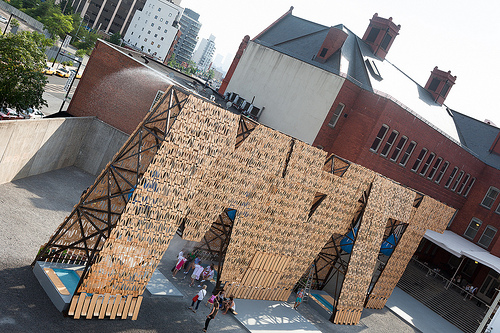
July 29, 2013
A Coda on Party Wall

Party Wall, MoMA PS1, CODA, 2013. Photo © Zachary Tyler Newton
“If you follow art and can’t stomach a certain level of pretentiousness, you’ll forever be stuck in the shallow end of the pool.” This nugget of wisdom comes from New York Times book critic Dwight Garner, from a review of Draw It With Your Eyes Closed, a collection of projects from Paper Monument, the art-centric offshoot of the literary magazine N+1. I’ve found it applies equally to the field of architecture, and it came to mind last week when I read a review of the latest MoMA PS1 installation on the website of Architect magazine.
First a little about the installation, Party Wall, designed by Caroline O’Donnell and her firm CODA. It’s a monumental construction, a steel skeleton with a skin of recycled wooden frameworks used in the manufacture of skateboards. Inside, enormous blue bladders — imagine a boxers’ speed bag blown up to brobdingnagian proportion — are suspended over small wading pools and seating decks. The bladders are filled with water, an engineering solution to the wind load against the structure. Overall it makes a dramatic impression. On first viewing (I saw it on a tour with the architect) it seemed to me like the bastard offspring of the Sandcrawler from Star Wars and Archigram’s Plug-In City. If you’re there at the right time of day, and it’s sunny, and you can get to a suitable perch, you may notice that the piece’s shadow spells WALL.
Now to that piece in Architect. It’s well written, but the arguments strike me as largely subjective. It’s too beige to be dramatic. (Would you say that about Salk? La Tourette?) You can’t easily see what it spells out. (If it was easier to read, it would have been pegged as too on-the-nose.) The detachable elements — skateboards retrofitted to be seating elements — were not detached from the structure during dance parties. (They are supposed to be out of the way during the dance parties.)
This is the paragraph that really put me in mind of Garner’s aphorism:
The use of the reclaimed-wood skateboard offcuts seems at first glance like a nice touch. Then, you realize that the skateboard company in question sells itself as eco-friendly to begin with, so the scrap wood wasn’t likely to be wasted, anyway. Then, you read Gizmodo’s Kelsey Campbell-Dollaghan, who asked O’Donnell about whether transporting all that wood from Ithaca, N.Y., to Queens really falls under the rubric of “eco-friendly,” and it turns out that some of the skateboards actually hail from San Francisco — almost 3,000 miles away. And that many of the skateboards were in fact “longboards,” which presumably did not make the press release because “longboard” just doesn’t sound as hip and with-it.
Do we really need to parse the difference between longboards and skateboards in this context? More to the point, just how ecologically correct do we need to be in our world of persistent compromise — especially in the context of a temporary party pavilion. Because the wooden boards might have been recycled by someone else, there’s no credit for using them here?
The piece goes on to compare Party Wall with Wendy, last year’s installation by HWKN, which is lauded for the use of fabric that “scrubbed away air pollution.” But that piece — and I liked it very much—hardly made any serious impact on local polution levels, and was itself probably not carbon neutral, so if you’re seriously looking to evaluate the relative environmental merits of these two projects…well good luck with that.
Sometimes it’s healthy to give a project a little bit of intellectual leeway.
Observed
View all
Observed
By Mark Lamster
Related Posts

Graphic Design
Sarah Gephart|Essays
A new alphabet for a shared lived experience

Arts + Culture
Nila Rezaei|Essays
“Dear mother, I made us a seat”: a Mother’s Day tribute to the women of Iran

The Observatory
Ellen McGirt|Books
Parable of the Redesigner

Arts + Culture
Jessica Helfand|Essays
Véronique Vienne : A Remembrance
Recent Posts
A new alphabet for a shared lived experience Love Letter to a Garden and 20 years of Design Matters with Debbie Millman ‘The conscience of this country’: How filmmakers are documenting resistance in the age of censorship Redesigning the Spice Trade: Talking Turmeric and Tariffs with Diaspora Co.’s Sana Javeri KadriRelated Posts

Graphic Design
Sarah Gephart|Essays
A new alphabet for a shared lived experience

Arts + Culture
Nila Rezaei|Essays
“Dear mother, I made us a seat”: a Mother’s Day tribute to the women of Iran

The Observatory
Ellen McGirt|Books
Parable of the Redesigner

Arts + Culture
Jessica Helfand|Essays
